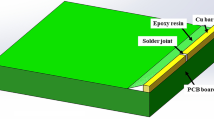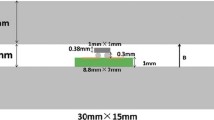Abstract
The high local temperature in flip-chip solder joints of microprocessors has raised concerns that the solder, a low melting temperature alloy, might locally liquefy and consequently cause failure of the microprocessors. This article reports a highly interesting electromigration behavior when the solder is in the molten state. A 6.3 × 103 A/cm2 electron current was applied to molten Sn3.5Ag solder at 255 °C through two Cu electrodes. The high current density caused rapid dissolution of the Cu cathode. The dissolved Cu atoms were driven by electrons to the anode side and precipitated out as a thick, and sometimes continuous, layer of Cu6Sn5. The applied current caused the dissolution rate of the Cu cathode to increase by one order of magnitude. A major difference between the electromigration in the solid and molten state was identified to be the presence of different countering fluxes in response to electromigration. For electromigration in the molten state, the back-stress flux, which was operative for electromigration in the solid state, was missing, and instead a countering flux due to the chemical potential gradient was present. An equation for the chemical potential gradient, dμ/dx, required to balance the electromigration flux was derived to be dμ/dx = N°z*eρJ, where N° is Avogadro’s number, z* is the effective charge of Cu, e is the charge of an electron, ρ is the resistivity of the solder, and J is the electron current density.








Similar content being viewed by others
References
K.N. Tu: Recent advances on electromigration in very-large-scale integration of interconnects. J. Appl. Phys. 94, 5451 2003
J.W. Nah, J.O. Suh K.N. Tu: Effect of current crowding and joule heating on electromigration induced failure in flip chip composite solder joints tested at room temperature. J. Appl. Phys. 98, 013715 2005
L. Zhang, S. Ou, J. Huang, K.N. Tu, S. Gee L. Nguyen: Effect of current crowding on void propagation at the interface between intermetallic compound and solder in flip chip solder joints. Appl. Phys. Lett. 88, 012106 2006
Y.H. Lin, Y.C. Hu, C.M. Tsai, C.R. Kao K.N. Tu: In-situ observation of the void formation and propagation mechanism in solder joints under current stressing. Acta Mater. 53, 2029 2005
C.M. Tsai, Y.L. Lin, J.Y. Tsai, Y.S. Lai C.R. Kao: Local melting induced by electromigration in flip-chip solder joints. J. Electron Mater. 35, 1005 2006
M.O. Alam, B.Y. Wu, Y.C. Chan K.N. Tu: High electric current density induced interfacial reactions in the micro-ball grid array (μBGA) solder joint. Acta Mater. 54, 613 2006
Y.H. Lin, C.M. Tsai, Y.C. Hu, Y.L. Lin C.R. Kao: Electromigration induced failure in flip-chip solder joints. J. Electron Mater. 34, 27 2005
Y.C. Hu, Y.H. Lin C.R. Kao: Electromigration failure in flip-chip solder joints due to rapid dissolution of copper. J. Mater. Res. 18, 2544 2003
Y.H. Lin, C.M. Tsai, Y.L. Lin, J.Y. Tsai C.R. Kao: Electromigration induced metal dissolution in flip-chip solder joints. Mater. Sci. Forum 475–479, 2655 2005
H.Y. Lu, H. Balkan K.Y.S. Ng: Solid–liquid reactions: The effect of Cu content on Sn–Ag–Cu interconnects. JOM 57, 30 2005
T. Laurila, V. Vuorinen J.K. Kivilahti: Interfacial reactions between lead-free solders and common base materials. Mater. Sci. Eng., R 49, 1 2005
A. Hayashi, C.R. Kao Y.A. Chang: Reactions of solid copper with pure liquid tin and liquid tin saturated with copper. Scripta Mater. 37, 393 1997
H. Gan K.N. Tu: Polarity effect of electromigration on kinetics of intermetallic compound formation in Pb-free solder v-groove samples. J. Appl. Phys. 97, 063514 2005
V.I. Dybkov: Growth Kinetics of Chemical Compound Layers Cambridge International Science Cambridge 1998 135
M.L. Huang, T. Loeher, A. Ostmann H. Reichl: Role of Cu in dissolution kinetics of Cu metallization in molten Sn-based solders. Appl. Phys. Lett. 86, 181908 2005
Alloy phase diagrams, in ASM Handbook, Vol. 3 edited by H. Baker ASM International Materials Park, OH 1992 2–178.
Acknowledgment
The authors thank the National Science Council of Taiwan, Republic of China, for financial support through grants NSC-95-2221-E-002-441 and NSC-95-2811-E-008-004.
Author information
Authors and Affiliations
Corresponding author
Rights and permissions
About this article
Cite this article
Huang, J., Tsai, C., Lin, Y. et al. Pronounced electromigration of Cu in molten Sn-based solders. Journal of Materials Research 23, 250–257 (2008). https://doi.org/10.1557/JMR.2008.0024
Received:
Accepted:
Published:
Issue Date:
DOI: https://doi.org/10.1557/JMR.2008.0024




